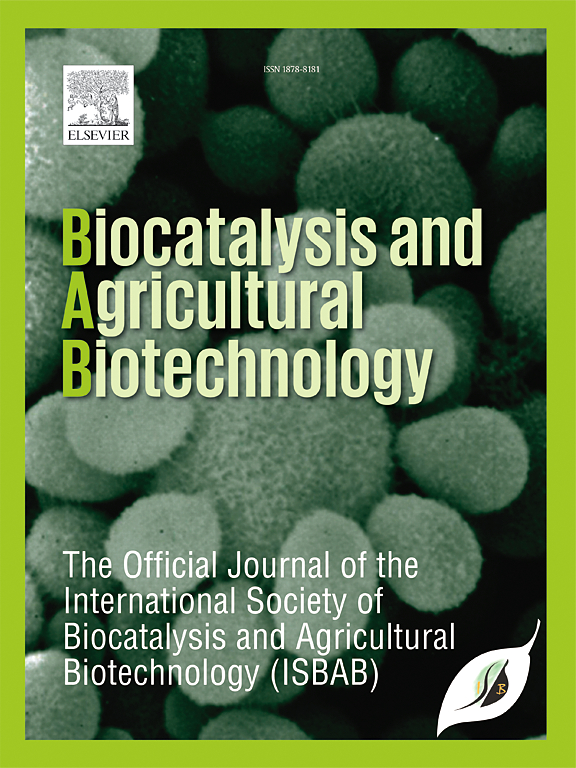Biosynthesis of silver nanoparticles using Bougainvillea flower extract: Antibacterial, antibiofilm and cytotoxicity studies
IF 3.4
Q2 BIOTECHNOLOGY & APPLIED MICROBIOLOGY
引用次数: 0
Abstract
This study investigated a sustainable approach for synthesizing silver nanoparticles (AgNPs) utilizing an extract from the flower of Bougainvillea glabra plant. The successful synthesis of AgNPs was confirmed by various biophysical techniques: UV–Vis spectroscopy revealed a prominent peak (432 nm), whilst FT-IR and XRD investigations confirmed their chemical composition and crystalline structure. TEM investigations indicated that the AgNPs measured around an average of 25.05 ± 0.87 nm and exhibited a spherical morphology. MIC values against gram-positive and gram-negative ranged from 32 to 128 μg/mL. The XTT assay shows that AgNPs at 500 μg/mL proficiently inhibits bacterial biofilm by 96 %. Light and electron microscopy investigations have indicated that AgNPs dramatically restrict their colonization and adhesion. SEM and TEM show that the cell surface exhibited irregularities, roughness, distortion, and an impaired state, characterized by a defective cellular membrane and its wall, signifying an impairment of membrane integrity that subsequently leads to cell death. Furthermore, the AgNPs exhibited a regulated toxic effect on breast cancer cells, inducing apoptosis while maintaining biocompatibility and sparing healthy cells. The promising results suggest that this eco-friendly way of making AgNPs could lead to new methods for delivering drugs to fight cancer and treat infections associated to biofilms.
九重葛花提取物生物合成纳米银:抗菌、抗生物膜和细胞毒性研究
本研究研究了一种利用三角梅花提取物合成银纳米粒子(AgNPs)的可持续方法。各种生物物理技术证实了AgNPs的成功合成:UV-Vis光谱显示了一个突出的峰(432 nm),而FT-IR和XRD研究证实了它们的化学成分和晶体结构。TEM研究表明,AgNPs的平均粒径为25.05±0.87 nm,呈球形。革兰氏阳性和革兰氏阴性的MIC值为32 ~ 128 μg/mL。XTT实验表明,500 μg/mL AgNPs对细菌生物膜的抑制率为96%。光镜和电镜研究表明,AgNPs极大地限制了它们的定植和粘附。扫描电镜和透射电镜显示,细胞表面表现出不规则、粗糙、扭曲和受损状态,其特征是细胞膜及其壁有缺陷,这表明细胞膜完整性受损,随后导致细胞死亡。此外,AgNPs对乳腺癌细胞表现出受调节的毒性作用,诱导细胞凋亡,同时保持生物相容性并保留健康细胞。这些令人鼓舞的结果表明,这种环保的制造AgNPs的方法可能会为抗癌和治疗与生物膜相关的感染提供新的药物方法。
本文章由计算机程序翻译,如有差异,请以英文原文为准。
求助全文
约1分钟内获得全文
求助全文
来源期刊

Biocatalysis and agricultural biotechnology
Agricultural and Biological Sciences-Agronomy and Crop Science
CiteScore
7.70
自引率
2.50%
发文量
308
审稿时长
48 days
期刊介绍:
Biocatalysis and Agricultural Biotechnology is the official journal of the International Society of Biocatalysis and Agricultural Biotechnology (ISBAB). The journal publishes high quality articles especially in the science and technology of biocatalysis, bioprocesses, agricultural biotechnology, biomedical biotechnology, and, if appropriate, from other related areas of biotechnology. The journal will publish peer-reviewed basic and applied research papers, authoritative reviews, and feature articles. The scope of the journal encompasses the research, industrial, and commercial aspects of biotechnology, including the areas of: biocatalysis; bioprocesses; food and agriculture; genetic engineering; molecular biology; healthcare and pharmaceuticals; biofuels; genomics; nanotechnology; environment and biodiversity; and bioremediation.
 求助内容:
求助内容: 应助结果提醒方式:
应助结果提醒方式:


